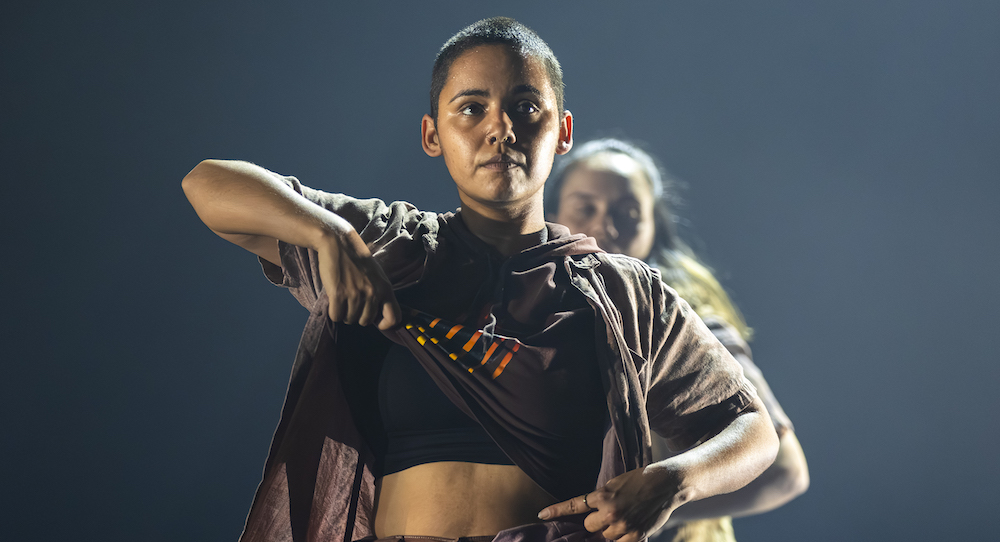Studio Theatre, Sydney Opera House, Sydney.
8 May 2024.
Gold Coast based Karul Projects presented SILENCE, created by Thomas E.S. Kelly (Minjungbal-Yugambeh, Wiradjuri and Ni-Vanuatu) and produced by BlakDance, at the Sydney Opera House this May, following performances around the country since September 2020. Karul Projects is a performing arts company created by Indigenous dance artists Thomas E.S. Kelly and Taree Sansbury (Kaurna, Narrunga and Ngarrindjerri), with a focus on increasing the First Nations voice, telling stories that advocate for cultural awareness to be shared locally, nationally and internationally.
SILENCE explores aspects of the fact that no treaty has been signed between the First Nations people of Australia and the colonizing people, and they are the only remaining sovereign people group in the Commonwealth, that have not had a treaty signed with them. It is a powerful work from this respect, and they are not backwards in coming forwards.
The work has a potent soundtrack, with live drumming and singing by Jhindu-Pedro Lawrie (Mirning and Wuthathi) layered over dance tracks, singing in indigenous language, group spoken voices, including a really powerful section of overt protest repeating the statement ‘Always was, always will be, Aboriginal land.’ This was a particularly powerful moment that stuck, like an intentionally catching song that won’t leave the head, and drives home deep as only music and movement with a pulsating rhythm can do.
The movement style draws strongly from traditional Aboriginal dance forms and symbolism, with a contemporary dance structure and vocabulary alongside a hip hop influence, a genre also steeped in cultural significance, a movement form that has been used to battle and wage culture wars, and is aptly woven into this work. There is an ebb and flow, rhythm, shape and voice unique to Kelly and Karul Projects, that is so easy to watch and be transported by, creating a very special work. The stylistic edge to the choreography is quite stunning and unique. The team of dancers (Kelly; Sansbury; Benjin Maza Yidindji, Birri Gubba, Meriam Mer and Tanna Island; Keia McGrady, Githabul Migunberri-Yugumbeh; Glory Tuohy-Daniell, Indjalandji-Dhidhanu and Alyewarre; Olivia Adams, Wulli Wulli; Tamara Bouman, Birpai) work together, moving as one, holding the rhythm of the work and the message so strongly within their bodies and their voices.
Connection to the land is explored in a multilayered approach, with dirt is spread all over the stage creating a tangible connection. The tactility of this work is grounding and drives home the message of connection to country that is so precious to our Indigenous peoples. The choreography moves with the dirt, flowing, falling and rolling so fluidly, with a stunning sense of rhythm. The symbolism at the end of the work, each performer pouring dirt into the performers hand next to them in a line was incredibly powerful, a return of the land, as the dirt flows through one to the next. Key moments in First Nations recent history is also explored, particularly the recent decades attempts at treaty that have consistently fallen through, and memorable moments in sport and culture where Aboriginal people have made a significant stand.
SILENCE is not a work that is backwards in coming forwards. You can hear and feel the frustration, the yearning for a new and different day. Humour is engaged, and perspective is shifted. SILENCE is a thought-provoking work, bringing the conversation back to fore. A conversation that has been happening for years, with no tangible result. This is not a reflective work so much as it is an outcry, and a present but poignant statement. Kelly has created a significant, ingenious protest, within which there is a unique choreographic voice that is exciting and unique, a wonderful celebration of tradition blended with cutting edge. This work is very important one in the current landscape of significant Australian work.
By Linda Badger of Dance Informa.















